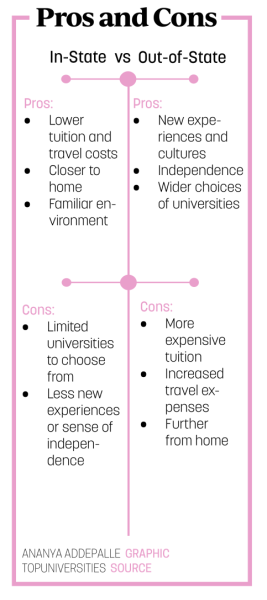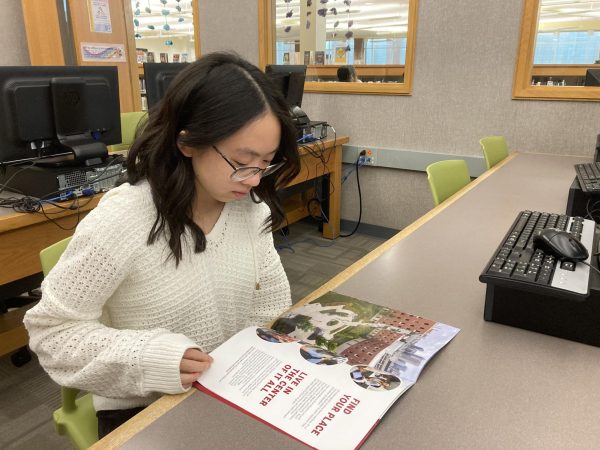For senior Alice “Allie” Mayer, the decision between in-state and out-of-state college is a complicated one. It encompasses a variety of factors including cost, proximity to family and “the right fit.”
“I’ve really kept (cost) in mind, especially when…they have the in-state tuition versus out-of-state tuition rates and you can see that the out-of-state tuition rate is so much more expensive. I’ve actually ruled out a few options because of that. I was looking at (The University of) Maryland, but it’s so expensive out-of-state that it’s not really a feasible option,” Mayer said.
Mayer said she is currently interested in both Ohio State and Purdue.
“Purdue, I’m leaning toward because in-state tuition is obviously a lot better than out-of-state, (but) I have to wait and see what scholarships I get,” Mayer said.
Mayer isn’t the only one impacted by this choice. In-state students in Indiana pay an average of $10,040 annually, while out-of-state students would pay $30,650 to attend one year of college here. Additionally, out-of-state prices can vary greatly nationwide.

Cost is a factor
According to Melinda Stephan, College and Career Resource Center programming coordinator, cost is a common theme during this process.
“A lot of times cost is the first thing that comes up. Usually, not always, but usually an in-state school, particularly a public institution, is going to be cheaper than an out-of-state school,” Stephan said.
Junior Aishwarya Ram said she’s considering IU and Purdue as her primary options for cost reasons.
“I chose in-state colleges (because) in-state fees are significantly lower than out-of-state fees,” she said.
But cost isn’t always as straightforward as in-state or out-of-state. Some schools offer something called reciprocity, where out-of-state students can pay a similar price to in-state tuition. Typically, these states border each other or are in the same geographical area.
One example is the Midwest Student Exchange Program (MSEP). Students at participating public universities will pay no more than 150% of the in-state tuition. Private universities involved in the program have at least a 10% reduction on tuition.
Additionally, for border counties and the nine counties in central Indiana (including Hamilton County), the University of Cincinnati offers the Metropolitan Rate, which is similar to an in-state tuition rate. Indiana residents would pay the Ohio-resident tuition rate, plus a $25 per credit hour extra charge.
Stephan said she believes this is a way for state universities to expand their reach.
“Sometimes it’s a marketing thing,” Stephan said. “(They) try to get students from multiple states, different perspectives and grow their enrollment.”
Family is important
But although cost is an important factor in college choice for Mayer, so is family. Throughout her college search, she said she has kept distance in mind and considered where relatives are in other states.

Stephan said proximity to family is a common concern in college choice, even with out-of-state schools.
“A lot of students come and say ‘I’m going to apply to these schools because I have a lot of family in Ohio. While I may be four to five hours away from home, I still have family nearby,’” Stephan said. “Most students, even out-of-state, stay in the Midwest… Illinois, Michigan, Ohio, Kentucky.”
Although there have been slight differences since COVID-19, around 30% of CHS graduates going to college attend in another state, according to Stephan, something that Ram and Mayer both see reflected in their lives.
Ram said she “barely knows anyone” who is studying out-of-state. Most of her friends who graduated last year have gone to Purdue or IU.
Mayer’s older sister is attending college out of state, but many of Mayer’s friends are planning to attend IU or Purdue, she said.
Finding the right fit
Beyond cost and proximity, a lot of students look for “fit,” including everything from major options to social life.
“My biggest factor by far is if they have my intended major,” Mayer said. “I want to go into microbiology which a lot of schools don’t actually have so that’s been a really easy way to rule out schools that I will not be applying to.”
Stephan said fit is usually an important factor in college choice.
“Where does a student see themselves thriving? For some students being out of their home but not being so far away is a place where they can kind of test their wings a bit and still thrive without feeling like they’re totally on their own,” Stephan said.
Ram said her biggest factor for college fit is feeling part of her school.
“(I want) to have a nice community of students and different class opportunities,” she said.
Mayer also said she has been keeping the culture of her college choices in mind throughout the process.
“Obviously there’s a lot of differences between bigger schools and smaller schools,” Mayer said. “If they have a big Greek life or if they have more STEM-oriented majors. So I think keeping all of those factors in mind when you’re thinking about what kind of environment you want to be in for the next four years is really important.”

































![What happened to theater etiquette? [opinion]](https://hilite.org/wp-content/uploads/2025/04/Entertainment-Perspective-Cover-1200x471.jpg)













































![Review: “The Immortal Soul Salvage Yard:” A criminally underrated poetry collection [MUSE]](https://hilite.org/wp-content/uploads/2025/03/71cju6TvqmL._AC_UF10001000_QL80_.jpg)
![Review: "Dog Man" is Unapologetically Chaotic [MUSE]](https://hilite.org/wp-content/uploads/2025/03/dogman-1200x700.jpg)
![Review: "Ne Zha 2": The WeChat family reunion I didn’t know I needed [MUSE]](https://hilite.org/wp-content/uploads/2025/03/unnamed-4.png)
![Review in Print: Maripaz Villar brings a delightfully unique style to the world of WEBTOON [MUSE]](https://hilite.org/wp-content/uploads/2023/12/maripazcover-1200x960.jpg)
![Review: “The Sword of Kaigen” is a masterpiece [MUSE]](https://hilite.org/wp-content/uploads/2023/11/Screenshot-2023-11-26-201051.png)
![Review: Gateron Oil Kings, great linear switches, okay price [MUSE]](https://hilite.org/wp-content/uploads/2023/11/Screenshot-2023-11-26-200553.png)
![Review: “A Haunting in Venice” is a significant improvement from other Agatha Christie adaptations [MUSE]](https://hilite.org/wp-content/uploads/2023/11/e7ee2938a6d422669771bce6d8088521.jpg)
![Review: A Thanksgiving story from elementary school, still just as interesting [MUSE]](https://hilite.org/wp-content/uploads/2023/11/Screenshot-2023-11-26-195514-987x1200.png)
![Review: "When I Fly Towards You", cute, uplifting youth drama [MUSE]](https://hilite.org/wp-content/uploads/2023/09/When-I-Fly-Towards-You-Chinese-drama.png)
![Postcards from Muse: Hawaii Travel Diary [MUSE]](https://hilite.org/wp-content/uploads/2023/09/My-project-1-1200x1200.jpg)
![Review: "Ladybug & Cat Noir: The Movie," departure from original show [MUSE]](https://hilite.org/wp-content/uploads/2023/09/Ladybug__Cat_Noir_-_The_Movie_poster.jpg)
![Review in Print: "Hidden Love" is the cute, uplifting drama everyone needs [MUSE]](https://hilite.org/wp-content/uploads/2023/09/hiddenlovecover-e1693597208225-1030x1200.png)
![Review in Print: "Heartstopper" is the heartwarming queer romance we all need [MUSE]](https://hilite.org/wp-content/uploads/2023/08/museheartstoppercover-1200x654.png)



